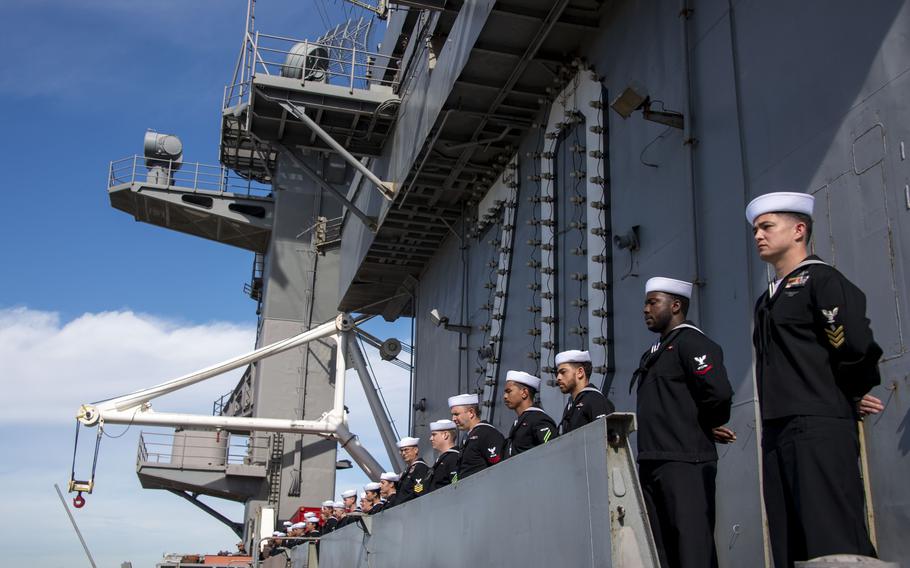
Sailors line the rails as the aircraft carrier USS Carl Vinson returns home in February. The ship is named for the longtime congressman known for his steadfast support of the Navy and his opposition to racial desegregation. (U.S. Navy)
Congress is taking aim at the Navy tradition of selecting untraditional names for its new ships and submarines.
A report by the Congressional Research Service, a public policy research institute for Congress, found inconsistencies and exceptions to traditional ship-naming protocols stoke public perception that the process is rife with politics.
“Observers have perceived a breakdown in, or corruption of, the rules,” according to the report released in February.
The shifting politics of presidential administrations, congressional majorities and public lobbying have warped the system in deciding who is honored with their name on a ship.
The report comes as the Navy prepares to name the fifth Ford-class aircraft carrier, the next block of Virginia-class attack submarines, missile frigates and troop ships.
It focuses on the attack submarines. Of the first 30 commissioned since 2003, all but two were named for states.
“But the most recent seven have been named for four earlier U.S. Navy attack submarines, a former secretary of the Navy, an island, and a city, suggesting that there is no longer a clear naming rule for the class.”
The issue is timely, the report said, because the Navy is on ship-buying overdrive, with nearly 90 vessels on order and maximizing the capacity of American shipyards.
The names chosen will likely remain in the fleet for a half-century or more. The largest and most prestigious vessels — aircraft carriers and submarines — have service lives of up to 50 years.
The names are crucial to politicians, the public and each ship’s crew.
“It’s important if you are serving on a ship,” said Thomas Cutler, a naval historian at the U.S. Naval Institute. “You want to be on a ship with a name with a lot of history, like Lexington or Saratoga, or a state or a city. You don’t want to be on a ship where you have to explain the funny name that’s someone nobody has heard of.”
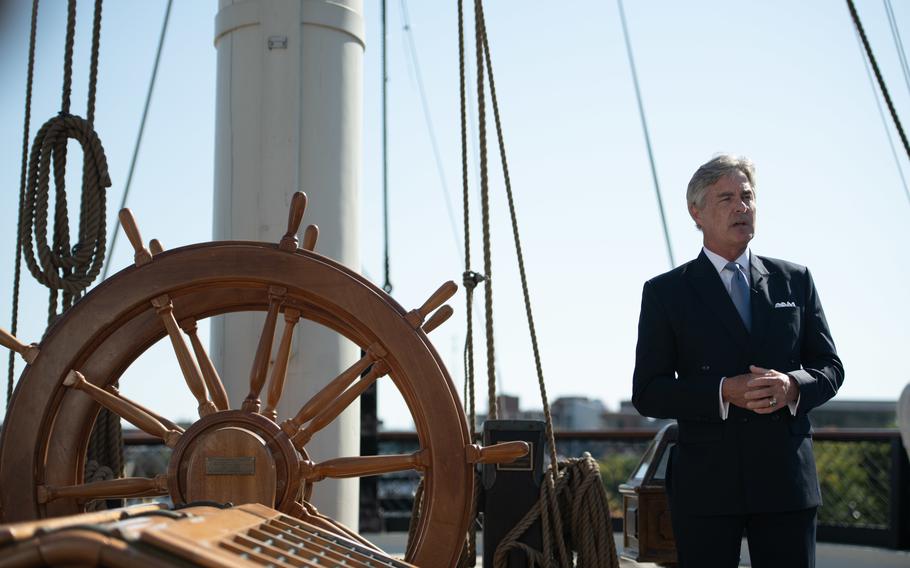
Then-Navy Secretary Kenneth Braithwaite, aboard the 18th century museum ship USS Constellation in Baltimore harbor, announced in 2020 that a new class of guided-missile frigates would be named after the ship, one of the first six Navy frigates ordered under President George Washington. (U.S. Navy)
Changing times, changing names
Since the Navy was founded in 1775, attempts have been made to formalize rules for naming the more than 7,000 ships that have served in the fleet.
The first rule held up until the sixth ship.
The 1794 Naval Act called for building six frigates with names reflecting the new nation’s principles: United States, Constitution, President, Congress and Constellation.
However, then-Navy Secretary Thomas Pickering opted for geography over ideology for the sixth ship, naming it the USS Chesapeake, after the shipyard location where it was built.
“The very first naming decision by the very first secretary of the Navy resulted in a ‘corruption’ of the established naming convention,” according to a 2012 report to Congress by four historians tasked with documenting Navy ship names.
With a relatively small Navy, U.S. ships in the first half of the 19th century mostly stuck to a traditional set of names — battles (Yorktown), states (Delaware), Founding Fathers (Franklin), Native American tribes (Chippewa), aggressive animals (Rattlesnake) and patriotic names (Independence).
More unusual names would show up when the Navy purchased an existing ship and kept the name such as the USS Ganges. Captured enemy ships either kept their original names such as the HMS Little Belt, a British ship that became the USS Little Belt, or the American captain was permitted to name the prize to be added to the Navy. For example, the Canadian schooner Lord Nelson seized during the War of 1812 became the USS Scourge.
The onset of the Civil War in 1861 saw shipyards in the northern states go into overdrive, turning out wooden and ironclad ships of every shape and purpose as well as buying merchant vessels. Ships were given names and sent into service rapidly. A New York City ferry drafted into Union service was named the USS Hunchback. The Union fleet included the USS Snowdrop, USS Hibiscus, USS Switzerland and other unique warship names.
After World War I, attempts to categorize warships by how they were named became more consistent. The massive buildup of the Navy for World War II made keeping within the naming protocols a way to avoid confusion.
However, World War II also created structural changes that challenged naming traditions.
Mark Cancian, a retired Marine colonel and now a senior adviser with the think tank Center for Strategic and International Studies in Washington, said the war rapidly converted a Navy of battleships and cruisers to a service of aircraft carriers and submarines.
“I’d say I am a traditionalist,” he said. “Battleships should be named after states, cruisers after cities and submarines after fish. But we haven’t built a battleship since World War II.”
Congress suggests, Navy chooses
Fewer, more expensive vessels that take longer to build have led to a political competition for naming rights.
One issue that the congressional report underlines is timing. It’s not unusual for the Navy to name the first of a new class of vessels when production begins. In 2016, the Navy said its new ballistic missile submarines would be the Columbia class, named for the nation’s capital.
Work on the first submarine began in June 2022. It was redesignated as the USS District of Columbia since the Navy already had a USS Columbia named after the city in South Carolina. The class retained the shorter “Columbia-class” name.
Despite the already mounting delays, the Navy announced in 2020 that the second submarine would be named the USS Wisconsin.
The executive branch decides the names of new ships, but Congress always has plenty of suggestions.
The report lists more than 50 resolutions and bills since 1987 calling on the Navy to name a ship after a state, city, battle, famous former vessel, or, most often — a specific person, ranging from House committee chairpersons to a Navy cryptographer killed in a terrorist attack.
In 1969, the Navy officially decreed ships should not be named for living people or members of Congress.
The rules were soon scuttled by former President Richard Nixon, who was a Navy officer during World War II.
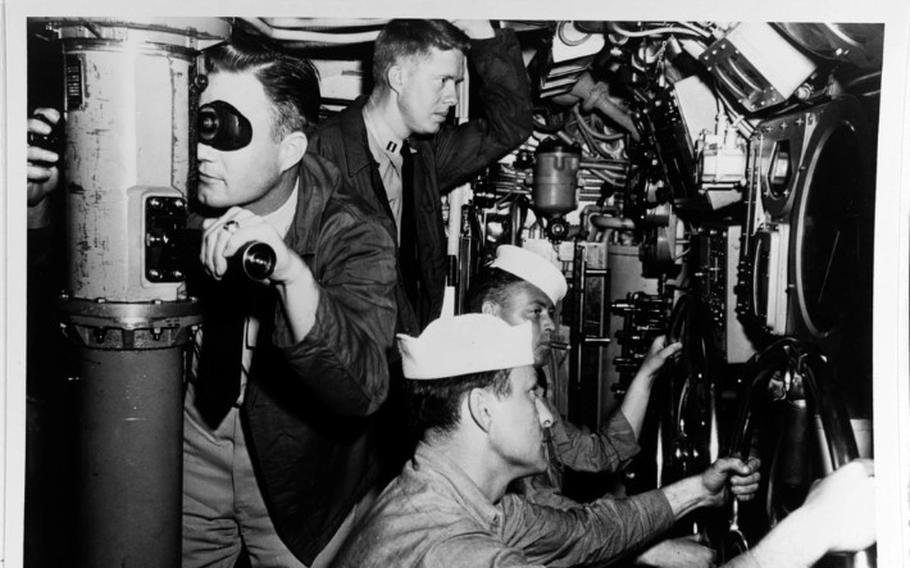
Navy Lt. Jimmy Carter aboard the submarine USS Barracuda in the early 1950s. A Seawolf-class attack submarine was later named for the former president. (U.S. Navy)
Four attack submarines were named after deceased lawmakers, and in a 160-year first, a living congressman was honored with his name on the third Nimitz-class supercarrier: the USS Carl Vinson.
The report notes the Navy named ships after 18 more people who were alive when ships were christened with their names. The list includes former Presidents Jimmy Carter, George H.W. Bush and Gerald Ford.
Ship names can steer right or left
Political liberals have criticized the naming of ships as late as the 1980s for Confederates who rebelled against the United States, including Civil War Gens. Robert E. Lee and Stonewall Jackson.
Carriers named after Vinson and former Sen. John Stennis honor lawmakers who were fierce supporters of the Navy but just as fierce opponents of racial desegregation.
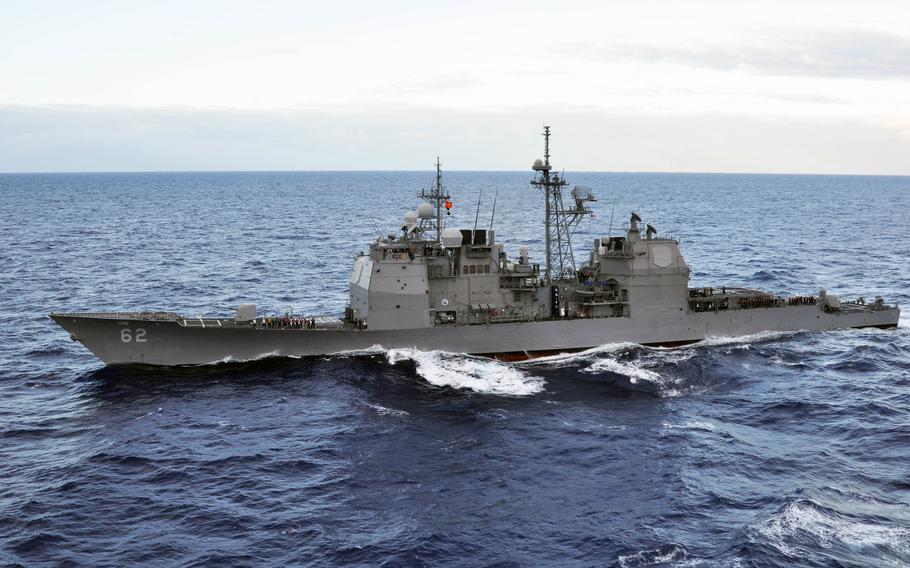
The cruiser then known as the USS Chancellorsville at sea in 2010. Named after a Confederate battle victory during the Civil War, it was renamed the USS Robert Smalls for an escaped slave who stole a Confederate ship and took it to a Union port. Smalls later served in Congress. (U.S. Navy)
The same law that directed the Army to rename bases that “honor or commemorate the Confederacy” required renaming the cruiser USS Chancellorsville, the bloody 1863 Civil War battle in Virginia often touted as Lee’s greatest victory. It’s now the USS Robert Smalls, named for a runaway slave who stole a Confederate ship to make his getaway to a Union port. Smalls later served in Congress.
The Navy also changed the USNS Maury, an oceanographic survey ship named after Matthew Fontaine Maury, who was a famed oceanographer who joined the Confederacy. The ship was renamed for Marie Tharp, who is best known for helping produce the first scientific map of the Atlantic Ocean floor.
Conservatives point to a whole class of Navy oilers that are named after civil rights leaders with few, if any, ties to the Navy. USNS are technically “noncommissioned” Navy support ships.
The John Lewis-class oilers are designated by the Navy to be named for civil rights leaders and activists. The lead ship was named for the black civil rights activist and longtime congressman. The USNS Harvey Milk is named for the gay rights activist forced to resign from the Navy in 1955. He was assassinated in 1978 while serving as a San Francisco commissioner.
The USNS Earl Warren, which is named for the liberal chief justice of the United States, and USNS Robert F. Kennedy were christened this year. Two ships named for women’s rights advocates, the USNS Lucy Stone and USNS Sojourner Truth, are under construction. The USNS Harriet Tubman will honor the abolitionist, while two ships for two other liberal former U.S. Supreme Court justices — the USNS Thurgood Marshall and USNS Ruth Bader Ginsburg — are on order.
The Lewis and Clark-class cargo ships were designated in the early 2000s under former President George W. Bush to be named for American explorers and pioneers. Early ships were named for arctic explorer Richard Byrd, aviator Amelia Earhart and Navy astronaut Alan Shepard.
Under former President Barack Obama, the definition was expanded to include “pioneers” in human rights. The USNS Medgar Evers was named for the assassinated civil rights leader, who was a World War II Army veteran. USNS Cesar Chavez was named for the farm worker rights activist who served in the Navy in World War II.
The loudest conservative complaints came with the naming of a littoral combat ship the USS Gabrielle Giffords, honoring the Democratic congresswoman from Arizona who was severely wounded in a 2011 assassination attempt that killed six others.
Giffords had not served in the military, and this set off demands for an investigation of naming “exceptions” by the Obama administration. A review found then-Navy Secretary Ray Mabus had followed traditional protocols in naming ships, with the exception of the USS Gabrielle Giffords.
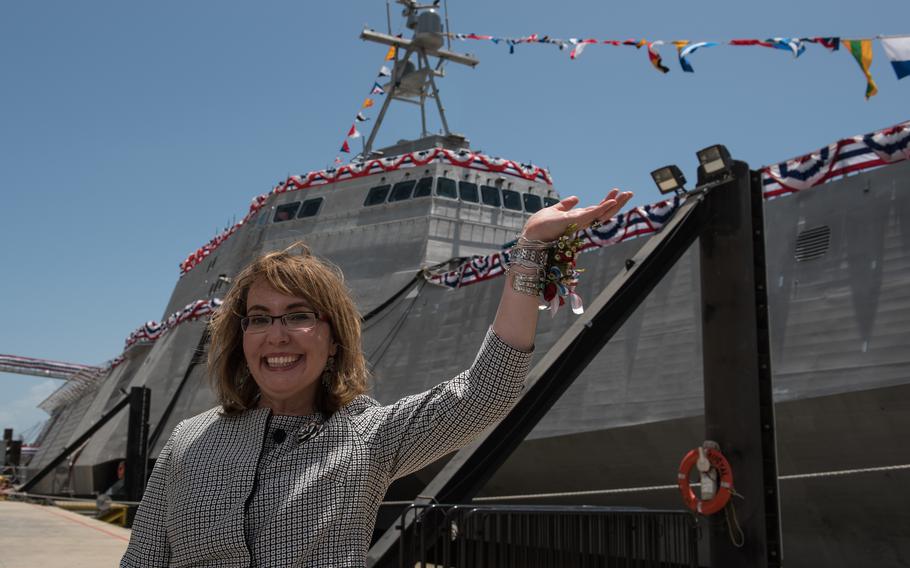
Former Rep. Gabby Giffords, D-Ariz., in June 2015 with the littoral combat ship named after her. (U.S. Navy)
Reflection, not reform
Some members of Congress contend the report reminds lawmakers to consider ship names beyond scoring political points with voters or key groups. However, a naming process without exceptions is not realistic.
A July 2012 congressional report on Navy shipbuilding allowed exceptions would continue to be the rule.
“A secretary’s discretion to make exceptions to ship-naming conventions is one of the Navy’s oldest ship-naming traditions,” the report said.
At one time, Navy tradition was to name submarines for sea creatures. Dozens named for fish and other denizens of the deep have served. The USS Pike was among the first Navy submarines, the USS Flasher sank more than 100,000 tons of enemy shipping in World War II and the USS Nautilus was the first atomic submarine.
While the USS Seawolf and the four planned Virginia-class submarines named for sea creatures were approved under former President Donald Trump, most submarines since the mid-1960s have names more often drawn from cities and states than the sea.
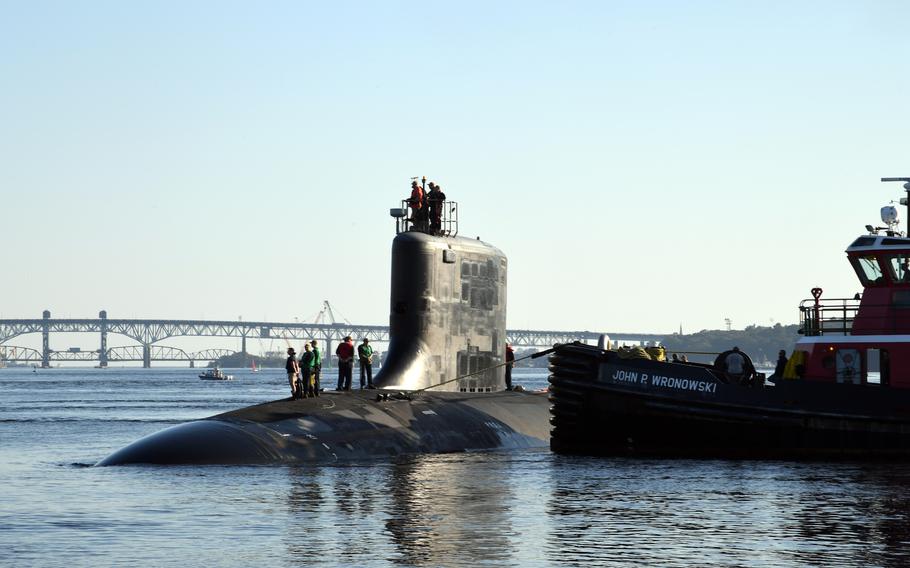
The future USS Hyman G. Rickover transits the Thames River on its way to Naval Submarine Base New London in Groton, Conn., on Oct. 3, 2023. (Joshua Karsten/U.S. Navy)
Adm. Hyman Rickover, the politically savvy “father” of the nuclear-powered Navy and its ever-expanding fleet of attack and ballistic missile submarines, was sanguine about the changes to tradition.
The names of battleships for states and cruisers for cities meant members of Congress with key votes on Navy budget bills could take a trophy back home to show constituents: the name of their city or state on a major warship that traveled the world and fought wars.
With no battleships and few cruisers being built after World War II, there were few trophies to be had. Rickover wanted more submarines for the Navy.
If the name changes meant the Navy received the funding it requested, he was willing to live with what won over congressional budgeters — and their voters.
Rep. Joe Courtney, D-Conn., represents a district that is home to the General Dynamics Electric Boat factory, where half of the new attack submarines are built, and the Naval Submarine Base New London.
He can recite the famous Rickover response to a subordinate Navy officer who lamented the loss of the traditional sea creature names to what he felt were more prosaic city and states.
“I’m a fan of Rickover,” Courtney said. “He said, ‘Fish don’t vote. People do.’ ”